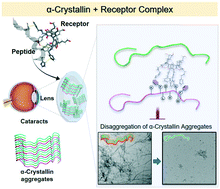Functionalized resorcinarenes effectively disrupt the aggregation of αA66-80 crystallin peptide related to cataracts†
Abstract
Cataracts, an eye lens clouding disease, are debilitating and while operable, remain without a cure. αA66-80 crystallin peptide abundant in cataracted eye lenses contributes to aggregation of αA-crystallin protein leading to cataracts. Inspired by the versatility of macrocycles and programmable guest selectivity through discrete functionalizations, we report on three water-soluble ionic resorcinarene receptors (A, B, and C) that disrupt the aggregation of αA66-80 crystallin peptide. A and B each possess four anionic sulfonate groups, while C includes four cationic ammonium groups with four flexible extended benzyl groups. Through multiple non-covalent attractions, these receptors successfully disrupt and reverse the aggregation of αA66-80 crystallin peptide, which was studied through spectroscopic, spectrometric, calorimetric, and imaging techniques. The αA66-80·receptor complexes were also explored using molecular dynamics simulation, and binding energies were calculated. Even though each of the three receptors can bind with the peptide, receptor C was characterized by the highest binding energy and affinity for three different domains of the peptide. In effect, the most efficient inhibitor was a cationic receptor Cvia extended aromatic interactions. These results highlight the potential of versatile and tunable functionalized resorcinarenes as potential therapeutics to reverse the aggregation of α-crystallin dominant in eye cataracts.



 Please wait while we load your content...
Please wait while we load your content...